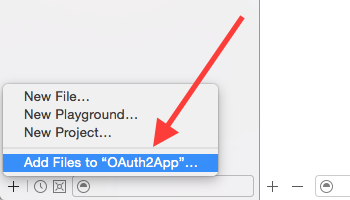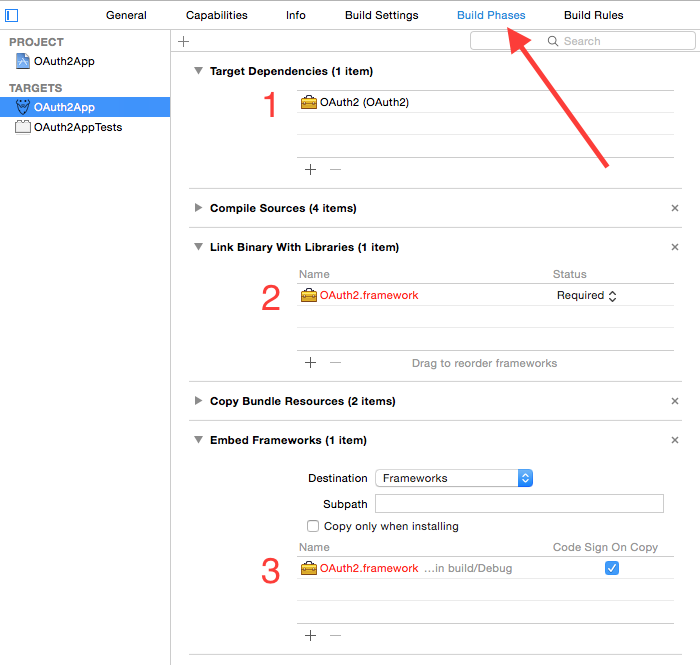OAuth2 frameworks for OS X and iOS written in Swift.
Technical documentation is available at p2.github.io/OAuth2. Take a look at the OS X sample app for basic usage of this framework.
The code in this repo requires Xcode 6, the built framework can be used on OS X 10.9 or iOS 8 and later.
To use on iOS 7 you'll have to include the source files in your main project.
Note that it's possible to run embedded frameworks in iOS 7 with some tricks, however you will not be able to submit such an App to the App Store.
Supported OAuth2 flows are the code grant (response_type=code) and the implicit grant (response_type=token).
Since the Swift language is constantly evolving I am adding tags that mark which revision should work with which Swift version.
Brand new Swift releases are likely to be found on the develop branch.
To use OAuth2 in your own code, start by importing it with import OAuth2 (use p2_OAuth2 if you installed via CocoaPods) in your source files.
For a typical code grant flow you want to perform the following steps.
The steps for other flows are mostly the same short of instantiating a different subclass and using different client settings.
If you need to provide additional parameters to the authorize URL take a look at authorizeURLWithRedirect(redirect:scope:params:).
-
Create a settings dictionary.
let settings = [ "client_id": "my_swift_app", "client_secret": "C7447242-A0CF-47C5-BAC7-B38BA91970A9", "authorize_uri": "https://authorize.smartplatforms.org/authorize", "token_uri": "https://authorize.smartplatforms.org/token", "scope": "profile email", "redirect_uris": ["myapp://oauth/callback"], // don't forget to register this scheme "keychain": false, // if you DON'T want keychain integration ] as OAuth2JSON // the "as" part may or may not be needed
-
Create an
OAuth2CodeGrantinstance. Optionally, set theonAuthorizeandonFailureclosures or just theafterAuthorizeOrFailureclosure to keep informed about the status. Note that afterAuthorizeOrFailure gets called immediately after either onAuthorize or onFailure. Hence, unless you have a reason to, you don't need to set all three callbacks.let oauth2 = OAuth2CodeGrant(settings: settings) oauth2.viewTitle = "My Service" // optional oauth2.onAuthorize = { parameters in println("Did authorize with parameters: \(parameters)") } oauth2.onFailure = { error in // `error` is nil on cancel if nil != error { println("Authorization went wrong: \(error!.localizedDescription)") } }
-
There are three ways to have the user authorize:
- An access token is still in the user's keychain
- User logs in via OS browser
- User uses a built-in web view (iOS only)
By default the OS browser will be used if there is no access token present in the keychain. If you want to use the embedded web-view, change
oauth2.authConfig.authorizeEmbeddedtotrue(remember, currently iOS only) and set a root view controller, from which to present the login screen if needed, as the authorize context. Then callauthorize():oauth2.authConfig.authorizeEmbedded = true oauth2.authConfig.authorizeContext = <# presenting view controller #> oauth2.authorize()
The
authorize()method will:- Check if an access token that has not yet expired is in the keychain, if not
- Check if a refresh token is in the keychain, if found
- Try to use the refresh token to get a new access token, if it fails
- Start the OAuth2 dance by using the
authConfigsettings to determine how to display an authorize screen to the user
If you do not wish this kind of automation, the manual steps to show the authorize screens are:
Embedded (iOS only):
let vc = <# presenting view controller #> let web = oauth2.authorizeEmbeddedFrom(vc, params: nil) oauth2.afterAuthorizeOrFailure = { wasFailure, error in web.dismissViewControllerAnimated(true, completion: nil) }
iOS/OS X browser:
if !oauth2.openAuthorizeURLInBrowser() { fatalError("Cannot open authorize URL") }
Since you opened the authorize URL in the browser you will need to intercept the callback in your app delegate. Let the OAuth2 instance handle the full URL:
iOS
func application(application: UIApplication!, openURL url: NSURL!, sourceApplication: String!, annotation: AnyObject!) -> Bool { // you should probably first check if this is your URL being opened if <# check #> { oauth2.handleRedirectURL(url) } }
OS X
See the OAuth2 Sample App's AppDelegate class on how to receive the callback URL in your Mac app.
-
After everything completes either the
onAuthorizeor theonFailureclosure will be called, and after that theafterAuthorizeOrFailureclosure if it has been set. You can use any of those. -
You can now obtain an
OAuth2Request, which is an already signedNSMutableURLRequest, to retrieve data from your server.let req = oauth.request(forURL: <# resource URL #>) let session = NSURLSession.sharedSession() let task = session.dataTaskWithRequest(req) { data, response, error in if nil != error { // something went wrong } else { // check the response and the data // you have just received data with an OAuth2-signed request! } } task.resume()
Based on which OAuth2 flow that you need you will want to use the correct subclass. For a very nice explanation of OAuth's basics: The OAuth Bible.
For a full OAuth 2 code grant flow you want to use the OAuth2CodeGrant class.
This flow is typically used by applications that can guard their secrets, like server-side apps, and not in distributed binaries.
In case an application cannot guard its secret, such as a distributed iOS app, you would use the implicit grant or, in some cases, still a code grant but omitting the client secret.
It has however become common practice to still use code grants from mobile devices, including a client secret.
This class fully supports those flows, it automatically creates a “Basic” Authorization header if the client has a client secret.
An implicit grant is suitable for apps that are not capable of guarding their secret, such as distributed binaries or client-side web apps.
Use the OAuth2ImplicitGrant class to receive a token and perform requests.
Would be nice to add another code example here, but it's pretty much the same as for the code grant.
A 2-legged flow that lets an app authenticate itself via its client id and secret.
Instantiate OAuth2ClientCredentials, as usual supplying client_id but also a client_secret – plus your other configurations – in the settings dict, and you should be good to go.
Some sites might not strictly adhere to the OAuth2 flow. The framework deals with those deviations by creating site-specific subclasses.
- Facebook:
OAuth2CodeGrantFacebookto deal with the URL-query-style response instead of the expected JSON dictionary. - GitHub:
OAuth2CodeGrantautomatically puts the client-key/client-secret into an “Authorization: Basic” header. GitHub however needs those two in the POSTed body; you need to set thesecretInBodysetting to true, either directly in code or via thesecret_in_bodykey in the settings dictionary. - Reddit:
OAuth2CodeGrantautomatically adds a Basic authorization header when a client secret is set. This means that you must specify a client_secret; if there is none (like for Reddit) specify the empty string. There is a RedditLoader example in the OAuth2App sample app for a basic usage example. - Google: If you authorize against Google with a
OAuth2CodeGrant, the built-in iOS web view will intercept thehttp://localhostas well as theurn:ietf:wg:oauth:2.0:oob(with or without:auto) callbacks.
This framework can transparently use the iOS and OS X keychain.
It is controlled by the useKeychain property, which can be disabled during initialization with the "keychain" setting.
Since this is enabled by default, if you do not turn it off during initialization, the keychain will be queried for tokens related to the authorization URL.
If you turn it off after initialization, the keychain will be queried for existing tokens, but new tokens will not be written to the keychain.
If you want to delete the tokens from keychain, i.e. log the user out completely, call forgetTokens().
You can use git or CocoaPods to install the framework.
Add a Podfile that contains at least the following information to the root of your app project, then do pod install.
If you're unfamiliar with CocoaPods, read using CocoaPods.
platform :ios, '8.0' # or platform :osx, '10.9'
pod 'p2.OAuth2'
use_frameworks!Using Terminal.app, clone the OAuth2 repository, best into a subdirectory of your app project:
$ cd path/to/your/app
$ git clone --recursive https://github.com/p2/OAuth2.git
If you're using git you'll want to add it as a submodule.
Once cloning completes, open your app project in Xcode and add OAuth2.xcodeproj to your app:
Now link the framework to your app:
These three steps are needed to:
- Make your App also build the framework
- Link the framework into your app
- Embed the framework in your app when distributing
NOTE that as of Xcode 6.2, the "embed" step happens in the "General" tab. You may want to perform step 2 and 3 from the "General" tab. Also make sure you select the framework for the platform (OS X vs. iOS). This is currently a bit tricky since Xcode shows both as OAuth2.framework; I've filed a bug report with Apple so that it also shows the target name, fingers crossed.
This code is released under the Apache 2.0 license, which means that you can use it in open as well as closed source projects.
Since there is no NOTICE file there is nothing that you have to include in your product.

